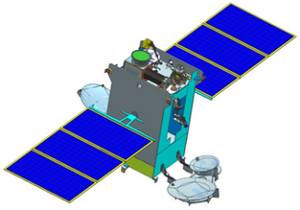Engineering:GSAT-29
 Render of GSAT-29 | |
| Mission type | Communication |
|---|---|
| Operator | ISRO |
| Mission duration | Planned: 10 years[1] Elapsed: 5 years, 8 months, 4 days |
| Spacecraft properties | |
| Bus | I-3K |
| Manufacturer | ISRO Satellite Centre Space Applications Centre |
| Launch mass | 3,423 kg (7,546 lb)[1][2] |
| Power | solar arrays, batteries |
| Start of mission | |
| Launch date | 14 November 2018 11:38 UTC [3] |
| Launch site | Satish Dhawan SLP |
| Contractor | ISRO |
| Orbital parameters | |
| Reference system | Geocentric |
| Regime | Geostationary |
| Slot | 55°E |
| Transponders | |
| Band | Ka, Ku, Q band, V band, and optical communication payload[2] |
GSAT-29 is a high-throughput communication satellite developed by the Indian Space Research Organisation (ISRO).[4][5] The mission aims at providing high-speed bandwidth to Village Resource Centres (VRC) in rural areas.[6] The two Ku and Ka operational payloads will provide communication services to Jammu and Kashmir and Northeast India under Digital India programme.[7] At the time of launch GSAT-29 was the heaviest satellite, weighing 3,423 kg (7,546 lb),[8] that was placed in orbit by an Indian launch vehicle.[9][10] Approved cost of GSAT-29 is Template:INR convert.[11]
Payloads
Apart from its main communication payload in Ka/Ku bands, GSAT-29 hosts few experimental payloads to mature their technology for use in future spacecraft.[12]
- Q band and V band payload: experimental microwave communication payloads
- Optical Communication Technology (OCT) payload: experimental payload for optical communication.[13]
- GEO imaging High Resolution Camera (GHRC): for high resolution imaging from geosynchronous orbit. It has 55 meter resolution and can image in six VNIR spectral bands at ~0.6 sec/frame.[14][15]
Launch
The satellite was launched on 14 November 2018 through the second developmental flight of LVM3,[16] that placed the GSAT-29 satellite into its planned geosynchronous transfer orbit (GTO) over the equator.[17] It joins the Indian National Satellite System (INSAT) fleet in geostationary orbit.[10]
| Op # | Date/ Time (UTC) |
LAM burn time | Height achieved | Inclination achieved |
Orbital period | References | |
|---|---|---|---|---|---|---|---|
| Apogee | Perigee | ||||||
| 1 | 15 November 2018 08:34 |
4875 sec | 35,897 km (22,305 mi) | 7,642 km (4,749 mi) | 8.9° | 13 hr | [18] |
| 2 | 16 November 2018 10:14 |
4988 sec | 35,837 km (22,268 mi) | 32,825 km (20,397 mi) | 0.31° | 22 hr, 70 min | [19] |
| 3 | 17 November 2018 04:25 |
207 sec | 35,875 km (22,292 mi) | 35,307 km (21,939 mi) | n/a | 24hr | [20] |
References
- ↑ 1.0 1.1 "GSAT-29". https://www.isro.gov.in/Spacecraft/gsat-29.
- ↑ 2.0 2.1 GSAT-29. Gunter Dirk Krebs, Gunter's Space Page. Accessed: 9 November 2018.
- ↑ William Graham (2018-11-14). "Indian GSLV rocket launches GSAT-29". https://www.nasaspaceflight.com/2018/11/indian-gslv-rocket-gsat-29-launch/.
- ↑ "GSLV-MkIII-D2/GSAT-29 Mission (Official)". https://www.isro.gov.in/gslv-mkiii-d2-gsat-29-mission.
- ↑ ISRO’s GSAT-29 launch in October. The Economic Times, India. 20 September 2018.
- ↑ d. s, Madhumathi (12 November 2018). "Cyclone clouds ISRO's GSAT-29 launch plan". The Hindu. https://www.thehindu.com/sci-tech/cyclone-clouds-isros-gsat-29-launch-plan/article25473500.ece.
- ↑ "Isro to launch communication satellite specifically for J&K and NE on Nov 14". The Times of India. 11 November 2018. https://timesofindia.indiatimes.com/india/isro-to-launch-communication-satellite-specifically-for-jk-and-ne-on-nov-14/articleshow/66580405.cms.
- ↑ "'India masters rocket science': Here's why the new ISRO launch is special". 15 November 2018. https://www.hindustantimes.com/india-news/india-masters-rocket-science-with-isro-sucessfully-launching-gsat-29-satellite/story-m72QQBzx7fxEYLyyoMRgPI.html.
- ↑ "ISRO successfully launches its heaviest satellite GSAT-29 from Sriharikota". 14 November 2018. https://economictimes.indiatimes.com/news/science/isro-successfully-launches-its-heaviest-satellite-gsat-29-from-sriharikota/videoshow/66621463.cms.
- ↑ 10.0 10.1 The third and final orbit raising operation of GSAT-29 ISRO 17 November 2018
- ↑ "Government of India, Department of Space, Lok Sabha: Starred Question No. 232 to be answered on Wednesday, August 04, 2021". 4 August 2021. http://164.100.24.220/loksabhaquestions/annex/176/AS232.pdf.
- ↑ "GSAT-29 - ISRO" (in en). https://www.isro.gov.in/Spacecraft/gsat-29.
- ↑ "SAC Courier, VOl. 43, Issue 03, July-October 2018". 10 January 2019. p. 5. https://www.sac.gov.in/SACSITE/SAC%20Courier/July_Oct_2018.pdf.
- ↑ Pandya, Mehul; Pradhan, Rohit (2019-09-26). "A study of rocket exhaust plume in the lower atmosphere using GHRC instrument onboard geostationary satellite". 4th ISSE National Conference 2019. https://www.researchgate.net/publication/336412752.
- ↑ "ISRO Director Kailasavadivoo Sivan Press Meet Live" (video) (in हिन्दी). 14 November 2018. Event occurs at 8 minute 35 seconds.
- ↑ "Isro gets nod for semi-cryogenic engine, will boost GSLV's lift capability by 1 tonne". The Times of India. 8 June 2018. https://timesofindia.indiatimes.com/india/isro-gets-nod-for-semi-cryogenic-engine-will-boost-gslvs-lift-capability-by-1-tonne/articleshow/64499802.cms.
- ↑ "GSLV MkIII-D2 successfully launches GSAT-29". https://www.isro.gov.in/update/14-nov-2018/gslv-mkiii-d2-successfully-launches-gsat-29.
- ↑ "GSLV Mk III-D2 / GSAT-29 Mission: The first orbit raising operation...". Indian Space Research Organisation. 15 November 2018. https://www.isro.gov.in/update/15-nov-2018/gslv-mk-iii-d2-gsat-29-mission-first-orbit-raising-operation-of-gsat-29-satellite.
- ↑ "The second orbit raising operation...". Indian Space Research Organisation. 16 November 2018. https://www.isro.gov.in/update/16-nov-2018/gslv-mk-iii-d2-gsat-29-mission-second-orbit-raising-operation-of-gsat-29.
- ↑ "The third orbit raising operation...". Indian Space Research Organisation. 17 November 2018. https://www.isro.gov.in/update/17-nov-2018/third-and-final-orbit-raising-operation-of-gsat-29-satellite-has-been.
 |



